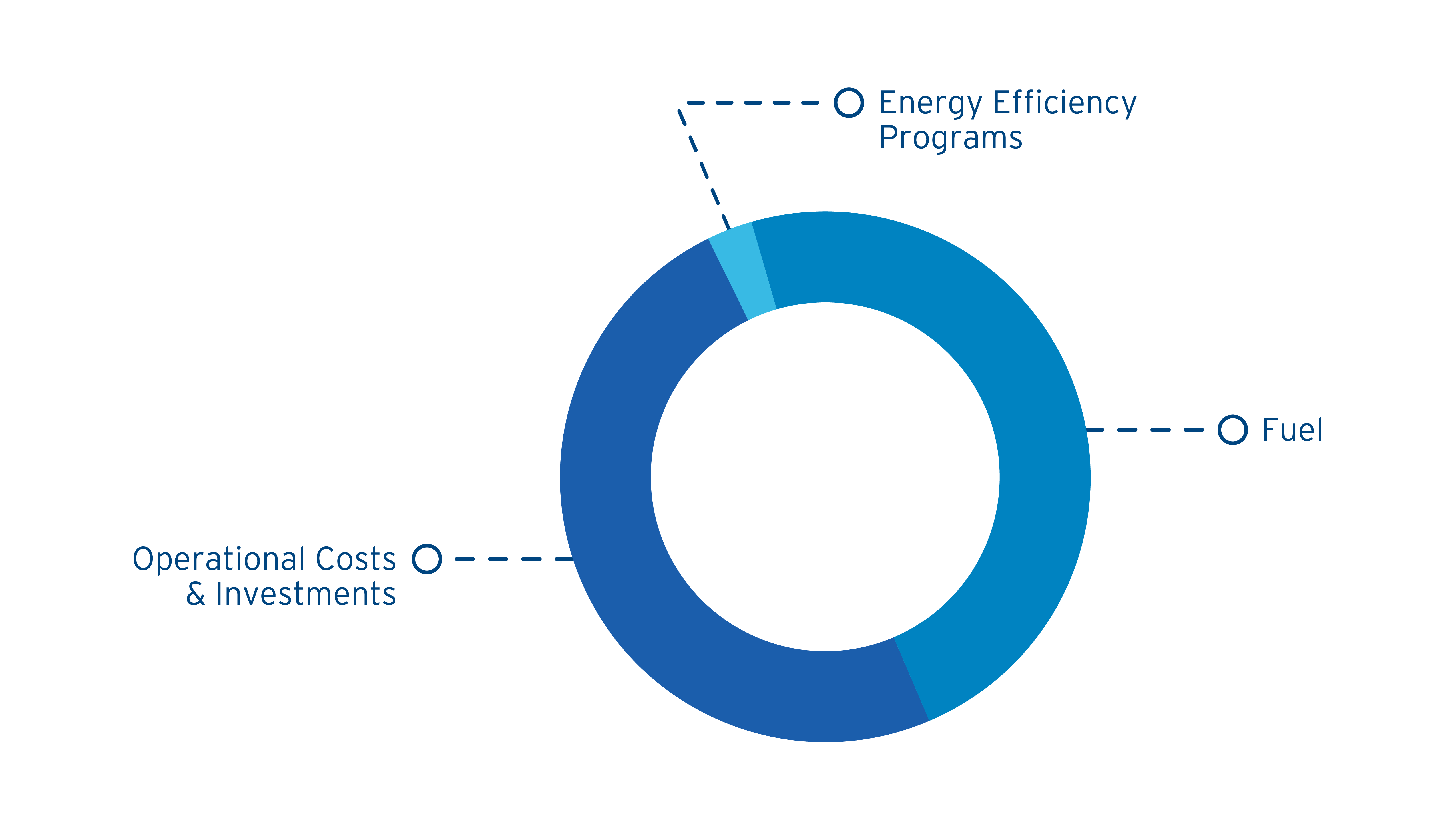In order to qualify for the TOD rate, you must have an electric-based space heating system that has the capacity to store heat with appropriate timing and controls in place and approved by Nova Scotia Power.

/time-of-day-(tod)/20220517-novascotiapower-peckhams-84.jpg?sfvrsn=f7094775_1)
By having these systems in your home, you could be eligible for the Time-of-Day (TOD) Rate. During the prime heating season (December to February), off-peak, mid-peak and peak rates apply. For all other months (March to November), you'll only experience mid-peak and off-peak. By programming your ETS to match these hours, your home will always be comfortable while also being cost-efficient.
From Monday to Friday during the months of December to February, you can program your ETS to store energy at off-peak hours when electricity cost is lower. The stored heat will be released during the peak times when cost of electricity is higher. Enjoy comfort and savings on weekends and holidays which are always off-peak hours.
/time-of-day-(tod)/tod-winter_weekdays.jpg?sfvrsn=395deef3_2)
/time-of-day-(tod)/tod-non-winter_weekdays.jpg?sfvrsn=a4b0f339_0)
/time-of-day-(tod)/tod-weekends_holidays_year-round.jpg?sfvrsn=80788b48_0)
24 Hours a day (Off-Peak): 12.340 ¢/kWh
All Nova Scotia Power rates for customers are subject to detailed review by stakeholders and the Nova Scotia Energy Board. Following this detailed review process, Nova Scotia Power must obtain the Nova Scotia Energy Board's approval for those customer rates. Rates are subject to change and become effective only after being approved by the Nova Scotia Energy Board.
To sign-up for the Time-of-Day Rate, you will need to contact an electrician to coordinate an electrical inspection before your rates can be changed.
In order to qualify for the TOD rate, you must have an electric-based space heating system that has the capacity to store heat with appropriate timing and controls in place and approved by Nova Scotia Power.
Qualifying customers will have their regular electric meter replaced with a time-of-day (TOD) meter. A TOD meter records the amount of power used, the time of day the usage occurred, and the season that we are in. The TOD meter even keeps track of the holidays when power is approximately half the standard residential rate. The TOD meter measures all activity requiring power and the customer is billed at the cost in effect when the power is used. As an example, a TOD customer doing their laundry on a weekday during the "on-peak" period is paying a premium price for the power they use. The same load of laundry during the "off peak" is at approximately half of the standard residential rate.
Your electric space heating and hot-water systems account for the majority of the electricity you use, so a significant way to save money is by using electricity at times when the lowest rates are in effect. You can do this automatically by using thermal storage for space heating and controlling your electric water heater. It's easy to cut costs even more by using appliances like your washer, dryer and dishwasher during the "off-peak" period. Optional appliance controls can help you do this automatically. All these things mean savings on your total electricity bill.
There are various electric-based space heating systems that qualify for use with the TOD rate because they draw energy during low cost "off-peak" times and store the heat for release later in the day. This is known as thermal storage.
A traditional electric-based space heating system uses power on demand and draws electricity as needed, when needed. An electric-based thermal storage space heating system draws the majority of its energy during "off-peak" times – saving you money.
The time-of-day (TOD) schedule is easy to follow. Power used on weekends, holidays and during nighttime hours (11:00 p.m. to 7:00 a.m.) is charged at the "off peak" rate (approximately half of the regular residential rate). It is during this "off-peak" time that an ETS heating system will draw power, convert the energy to heat, and store it for controlled release over the course of the day. Your water heater can be controlled to heat during this time as well.
The "mid-peak" period covers daytime power use from 7 a.m. to 11 p.m. from March to November and from 12 noon until 4 p.m. in December, January and February. During this time, the cost for electricity is at the regular residential rate, while the nighttime and weekend cost remains at approximately half price.
The "on-peak" (1.437 times the regular residential rate) period is in December, January and February from 7:00 a.m. - 12:00 noon and from 4:00 p.m. until 11:00 p.m. on weekdays only. During these months, energy used during nighttime hours (11:00 p.m. to 7:00 a.m.) and on weekends remains at approximately half the regular residential rate.
There are different times throughout the day, and different seasons throughout the year, when the demand for electricity is higher. Nova Scotia Power must be able to produce and distribute enough electricity to meet these high demand "peak" times, but during low-demand or "off-peak" times, there is plenty of generating capacity available. To encourage customers to use the majority of their electricity during "off-peak" times, Nova Scotia Power offers the TOD rate.
The time-of-day (TOD) rate is an optional rate available to residential customers. Customers who qualify for the rate can take advantage of low-cost electricity by focusing on the “time-of-day” the energy is used. The rate reflects the actual cost to generate the electricity and provides low-cost electricity during “off-peak” energy-times. Various electric-based space heating systems qualify for use with the TOD rate by storing heat and releasing it through appropriate timing and controls.
We are regulated by the Nova Scotia Energy Board—they are responsible for ensuring customers receive power at fair rates. The Nova Scotia Energy Board uses a “cost of service” method which ensures that rates are set at a level that will allow us to recover costs plus a reasonable profit. Without a reasonable return, investors would not be willing to invest in the utility.
A full breakdown of how rates are set by the Nova Scotia Energy Board can be found on their website.
Residential and business customers have two charges on their bills: a base charge and an energy rate. The base charge is a set charge for the cost of delivering and maintaining electricity service. The energy charge is the price per kWh of energy used, which changes based on energy use habits for that period. The energy charge includes costs associated with the fuel used to make electricity and energy efficiency programs.

The visual above is for demonstrative purposes only based on the standard residential rate (domestic service tariff). The monthly base charge would be additional.
FUEL (Fuel Adjustment Mechanism - FAM)
The cost of fuel and purchased power we require to serve customers and meet their electricity needs. This includes many forms of fuel like oil, coal, and biomass, as well as purchased power, including from hydro and wind facilities, as well as imported electricity. Learn more about fuel-related costs.
OPERATIONAL COSTS & INVESTMENTS (Non-Fuel)
The cost to invest in and maintain assets, such as generation facilities (making of power) and transmission and distribution infrastructure (delivery of power). Examples include our power plants, fleet trucks, and poles and wires.
ENERGY EFFICIENCY PROGRAMS (Demand Side Management Cost Recovery Rider - DSM)
The cost of delivering energy efficiency programs that encourage cost savings for customers. Learn more about Energy Efficiency Programs.
We offer different rate plans to provide you with options to suit your energy usage preferences and lifestyle.
/standard-rate/amherst---family-of-three-standing-in-front-of-a-house.jpg?sfvrsn=baba5bf9_3)
This is our standard, default rate, also known as the Domestic Service Tariff. It is a flat rate throughout the day, all year round.
Learn More/time-of-use/williamsfamilynspower-3573_nonetflix.jpg?sfvrsn=c2e70287_1)
Shift to save! Shift your weekly energy usage in the winter to save on your annual power bill by unlocking summer savings.
Learn More/critical-peak-pricing-(cpp)/nsp-shelburne-12.jpg?sfvrsn=e11dd1b7_3)
Beat the peak - Save money by shifting your energy use away from periods of peak demand for electricity.
Learn More